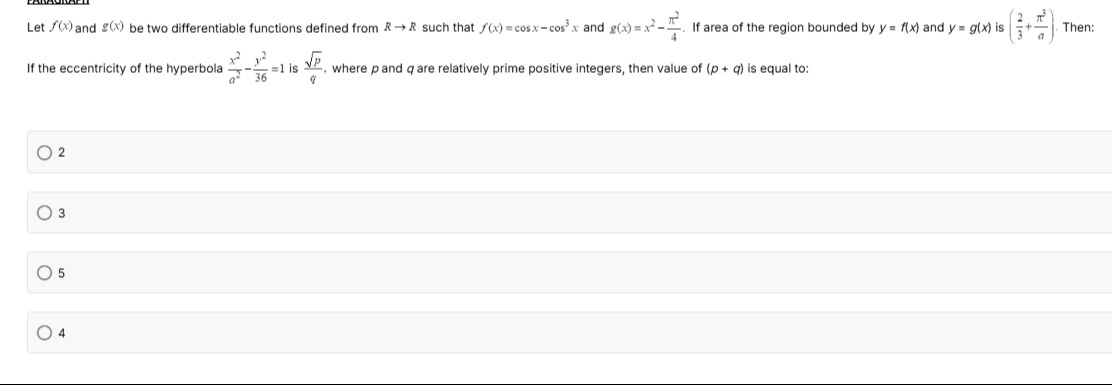Question
Question: Let $f(x)$ and $g(x)$ be two differentiable functions defined from $\mathbb{R} \to \mathbb{R}$ such ...
Let f(x) and g(x) be two differentiable functions defined from R→R such that f(x)=cosx−cos3x and g(x)=x2−4π2. If area of the region bounded by y=f(x) and y=g(x) is (32+aπ3). Then:
If the eccentricity of the hyperbola a2x2−36y2=1 is qp, where p and q are relatively prime positive integers, then value of (p+q) is equal to:

3
4
5
6
3
Solution
The problem consists of two parts. The first part involves calculating the area between two curves to find the value of a parameter 'a'. The second part uses this parameter to define a hyperbola and asks for a value derived from its eccentricity.
Part 1: Area Calculation The functions are f(x)=cosx−cos3x=cosx(1−cos2x)=cosxsin2x and g(x)=x2−4π2. We find the intersection points by setting f(x)=g(x). We note that f(±π/2)=0 and g(±π/2)=(±π/2)2−4π2=0. Thus, x=−π/2 and x=π/2 are intersection points. For x∈(−π/2,π/2), f(x)=cosxsin2x≥0 and g(x)=x2−4π2<0. Hence, f(x)>g(x) in this interval. The area A is given by: A=∫−π/2π/2(f(x)−g(x))dx=∫−π/2π/2(cosxsin2x−(x2−4π2))dx A=∫−π/2π/2cosxsin2xdx−∫−π/2π/2x2dx+∫−π/2π/24π2dx
Evaluating the integrals:
- ∫−π/2π/2cosxsin2xdx=[3sin3x]−π/2π/2=313−3(−1)3=31+31=32.
- ∫−π/2π/2x2dx=[3x3]−π/2π/2=3(π/2)3−3(−π/2)3=24π3+24π3=12π3.
- ∫−π/2π/24π2dx=4π2[x]−π/2π/2=4π2(2π−(−2π))=4π2(π)=4π3.
So, A=32−12π3+4π3=32+π3(41−121)=32+π3(123−1)=32+6π3. Given that the area is (32+aπ3), we compare the two expressions to find a=6.
Part 2: Hyperbola Eccentricity The hyperbola equation is a2x2−36y2=1. Substituting a=6, we get 62x2−36y2=1, which is 36x2−36y2=1. This is a hyperbola of the form A2x2−B2y2=1, with A2=36 and B2=36. The eccentricity e is given by e=1+A2B2. e=1+3636=1+1=2. We are given that the eccentricity is qp, where p and q are relatively prime positive integers. So, 2=qp. Squaring both sides gives 2=q2p, or p=2q2. For p and q to be relatively prime positive integers, the only solution is q=1, which yields p=2(1)2=2. Thus, p=2 and q=1. They are positive and gcd(2,1)=1. The problem asks for the value of (p+q). p+q=2+1=3.
